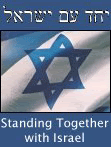Amona Investigation a Farce - Think Tank
Save this online in Del.icio.us. [?] Vote For this PostIsraelis were building a village in a place called Amona, in contravention to Israeli law. When people came to tear the buildings down, there were some clashes with riot police. While most of this article is clear and to the point, I'd like to put my own two cents in on the conclusion of Mr. Chodoff, who wrote this piece. First, Chodoff's wording in places suggests all the villagers rioted; it was a few bad apples. Second, his wording also suggests they're all criminals: "If convicted, they should be severely punished as befits the criminals they are." A neutral way to phrase that rather than hanging them in the court of public opinion would have been to write: "If convicted, they should be severely punished as befits the criminals they would then be recognized as." Note the difference: they're innocent until proven guilty, and as yet, they haven't been proven guilty. That said, here's the article from Middle East on Target's Elliot Chodoff into the investigations of the excessive violence at Amona by the riot police.
Amona Committee Farce
by Elliot Chodoff
The Knesset Foreign Affairs Committee has decided to convene a special investigative subcommittee on the events at Amona a few weeks ago. Unfortunately, the appointment of MK Uri Ariel threatens to turn the subcommittee from investigative to farcical.
Ariel, who was an active participant in the Amona events as a demonstrator against the government’s implementation of the Supreme Court decision to demolish 9 illegally built homes, may have a place before the committee as a witness, but not on it. In order for the committee to fulfill its task, it must be above any accusation of partisan bias. Given that the panel will be comprised of elected politicians, this is a daunting enough challenge that need not be exacerbated by accurate charges of conflict of interest.
Something clearly went wrong at Amona. An operation to clear and demolish a few houses, built illegally on private property ended with more than 200 injured, including some seriously, as the level of violence on the part of the demonstrators and the police forces far exceeded anything seen during the Gaza disengagement of August 2005.
Based on the experience of the disengagement from Gaza, demonstrators went to Amona with two diametrically opposed objectives. Some went with confidence that the Israel security system would treat them with the sensitivity shown to the residents of Gaza during the disengagement; others openly stated that they were intent on avenging the Gaza disengagement, particularly by preventing another nonviolent evacuation from Jewish settlements. To carry out their threats, they stockpiled rocks, building blocks and glass bottles to throw at police officers. In turn, the police charged into the settlement on foot and mounted on horseback, fully prepared to smash the riot before it had even begun.
Herein lies the problem. The antagonists in this tragedy are not symmetrical in strength, structure or public responsibility. While the demonstrators have a right to express their opposition to the demolition of homes in Amona or anywhere else, that right is neither unlimited nor does it include the right to use violence, as we have argued in the past. (See, “Deadly Tango,” Mideast: On Target Archives, July 1, 2005) The police are permitted to use violence in the line of duty as the state and its institutions retain the exclusive monopoly on the use of violence, but that use must be limited to the minimum necessary to maintain law and order. If they struck pre-emptively or excessively, they exceeded their authority.
The security forces were certainly threatened by the violent demonstrators at Amona, but it is far from clear that every reasonable alternative was exhausted before the order was given to use force to remove the demonstrators. In the Gaza disengagement, hundreds of man-hours of effort were invested to insure the peaceful conclusion of the operation, and the results speak for themselves. Regardless of the emotional trauma the residents went through and continue to endure, there were few cases of violence by residents, demonstrators or security forces, and these were extremely limited in scope and intensity, despite the best efforts of the news media to portray them otherwise.
The police and IDF forces that took part in the Amona evacuation should be closely investigated by an impartial Knesset committee. Their orders, assumptions intentions and methods must be scrutinized to insure and violence used by them was absolutely and unquestionably unavoidable. If unnecessary violence was either ordered or implemented without orders, those found responsible should face appropriate sanctions and punishment. However, the Knesset committee should not investigate the demonstrators who violently confronted the security forces; it is sufficient for them to be arrested by the law enforcement institutions of the country and handed over for trial by the justice system. If convicted, they should be severely punished under the law as befits they criminals they are.
--
Related:
Haveil Havalim (issues relating to Israel and Judaism)
Militant Islam Confronts Europe
Muhammad Cartoon Riots Irony: Photo Essay






2 Comments:
Although, as you know, we have no problem with re-printing of articles. We would appreciate it if in the future you would include a link to our home page in the article. In this case also since the article refers to another article in our web site.
thanks
www.me-ontarget.com
Oh, I apologize. I'll certainly add a link. Keep up the good work :).
Post a Comment
<< Home